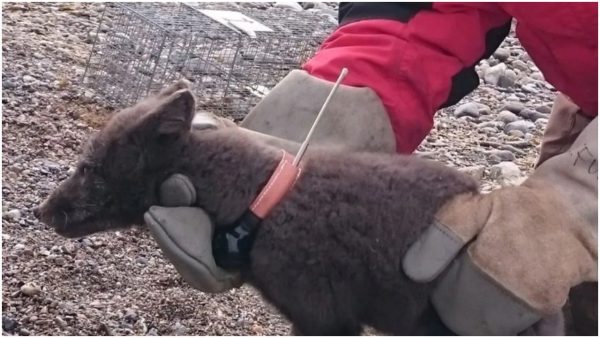Just Amazing: An Arctic Fox Walked 2,700 Miles From Norway to Canada
We occasionally hear stories about dogs who have been separated from their owners and make amazing, cross-country treks to return home. There have even been movies made about it. As uplifting as such stories are, they may have been outdone by a young arctic fox, according to the Washington Post.
The fox walked about 2,700 miles, starting out in Norway and ending up in Canada.
Her trek began when she left the island of Spitsbergen in Norway. Three weeks later, she was in Greenland, and less than three months after that, she had managed to hike to Nunavut, Canada. A group of researchers was tracking her journey, and at first, they thought the data they were getting was a mistake. The truth of it was established as she continued her hike.
NPR says the animal is a coastal or blue fox, and that her trip is the longest of its type that has ever been documented among members of her species. Scientists from the Norwegian Polar Institute put a tracking collar on her, which is how they knew where she was. In 2017, scientists at the institute wanted to study the spatial ecology of arctic foxes, which is to say how members of the species spread out and the impact that has on ecology.
Published this morning: “Arctic fox dispersal from Svalbard to Canada: one female’s long run across sea ice” https://t.co/vUvu4NbPEj This is the first satellite tracking of natal dispersal by an Arctic fox between continents. Authors: Eva Fuglei and Arnaud Tarroux pic.twitter.com/gowSov0OBA
— Polar Research (@PolarResearch) June 25, 2019
A number of foxes were fitted with tracking collars and released into the wild to see what they would do. In the case of this particular animal, at first, she stayed near the coast of western Spitsbergen but decided to leave in March 2018. She started moving, changing her direction whenever she was faced with open water.
Scientists already knew that arctic foxes had the endurance and sturdiness to survive polar environments since there is DNA evidence showing genetic links between foxes in lands that are only connected by sea ice. Even so, they were surprised and impressed with how much area this fox covered in a relatively short time. She averaged about 30 miles a day, but some days she traveled closer to 100.
She left the island by traversing sea ice, walking for 21 days before reaching Greenland on April 16, 2018, a whopping 939 miles away from where she began. Given the fact that the days she covered the most miles were when she was crossing the ice sheet in northwestern Greenland, it appears that she was using the ice more as her personal highway than as a hunting ground.

On July 1, 2018, she was shown to be on Ellesmere Island, in Canada. Her last known location was in Nunavut Territory on the Island, but her tracker stopped working in February of this year, so she could have stayed where she was or continued her journey without being tracked.
The scientists who have been tracking her believe that a shortage of food may have prompted her migration, although the exact cause hasn’t been absolutely identified. There were between 50 and 60 other foxes who also had tracking collars, but they all stayed in Norway.
At least one other fox of her type has traveled a similar distance, but that one took closer to six months to make the trek. That sort of long trip would be more common among a different breed, known as the lemming fox, following the movements of the lemmings that are the primary source of their food.
This particular fox’s long migration demonstrated clearly that the animal used sea ice as a means of covering distance and also gives some answers about how other specimens of her type have been unexpectedly seen in far northern regions, dating back as far as the late 1800s.
The long trek these foxes make certainly aids the survival and health of the species as a whole by increasing genetic diversity across the north.
Another Article From Us: The Largest Alligator Ever Captured in the USA Was on The Loose – It Has Now Been Found
Unfortunately, scientists may not have many more opportunities to witness dispersion events like this one, since warming global temperatures and the corresponding melting of sea ice will quickly preclude Icelandic foxes from being able to cross Arctic waters anymore, leaving them isolated.





